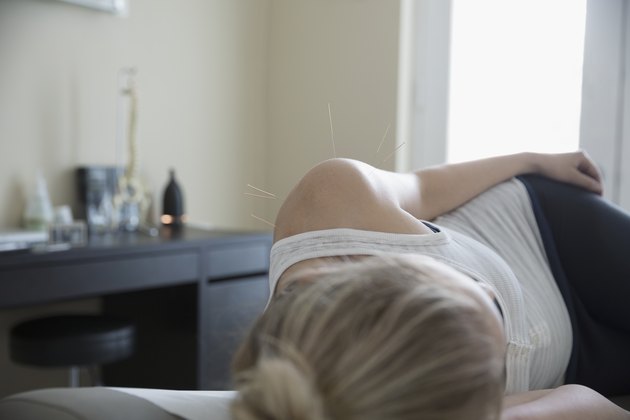If you have a tight bicep muscle, it will likely be uncomfortable to straighten your arm. Muscle knots in the forearm are the result of an injury that causes muscle spasms. If the spasm is not treated, it goes on to form knots in the muscle.

Advertisements
As you move around during the day, muscles cycle on and off with different movements. An untreated spasm makes the muscle stay contracted all the time. Eventually the muscle overloads and forms knots. Treating muscle spasm can help reduce biceps knots, but if the source of the pain isn't treated, the spasm and knots will recur.
Treatment for Knot in Bicep
Treatment for muscle knots in the biceps can be self-administered or obtained from a health care professional such as a physical therapist. Self-treatment options include stretching, local massage, the application of heat or cold and acupressure.
Other possible treatment modalities include massage therapy, acupuncture and the use of ultrasound or electrical stimulation. Physical therapists and massage therapists perform massage therapy; physical therapists also apply ultrasound or electrical stimulation.
Acupuncture and Acupressure
Acupressure and acupuncture are traditional Chinese bodywork therapies. Each is applied to specific points on the body called meridians. Acupressure is a variation of acupuncture; deep finger pressure on acupuncture points takes the place of the fine needles used in acupuncture.
You may be able to perform acupressure on your biceps muscle, but someone who is trained in acupressure should instruct you on the correct location and show you the technique.
Advertisements
Self-Bicep Massage
Some forms of massage can be self-administered, while others require a trained massage therapist. One form of bicep massage you can use on a knotted biceps is the glide.
To perform a glide, place your palm over the biceps muscle; keep your fingers together but hold your thumb so the thumb and index finger form a V. Glide your hand up and down the muscle with just enough pressure to indent the skin. Glide until you feel the muscle warm beneath your fingers. For a more intense massage, perform this technique using a spoon or other flat utensil.
Stretch Your Bicep
Stretching a muscle can reduce spasm and decrease the tendency for knots to form. Stretch after you have warmed up to prevent increased spasm.
To stretch your tight bicep muscle, place your outstretched hand in front of you on a wall at shoulder level. Keep the hand on the wall and rotate your body until you are facing away from the wall. You will feel a stretch in your biceps. Hold the position for 20 to 30 seconds at a time; then relax and repeat several times.
Considerations and Precautions
If you continue to experience knots in the biceps, you may be doing something that causes repeated muscle injury or you may have some other medical problem that makes you more prone to muscle spasm, such as a vitamin or mineral deficiency.
Low levels of calcium, magnesium, potassium or vitamin D can increase the tendency toward muscle spasm. Consult a health care professional for continued spasms or biceps knots that do not respond to self-treatment.
REFERENCES & RESOURCES Seth Rosenbaum M.D.: Muscle Spasm and Muscle Knots Athletico Physical Therapy: Stretch of the Week: Biceps Self-Massage New York-Presbyterian Hospital: Biceps Tendon Strengthening Exercises



Comments